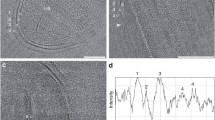Abstract
Two out of eleven newly isolated strains of Paracoccus denitrificans were investigated by light and electron microscopic methods and compared with two strains of P. denitrificans already kept in culture collections. Samples were taken from different growth phases revealing short rods and nearly spherical cells in the exponential growth phase, and an increasing ratio of nearly spherical cells in the stationary growth phase. Cell division followed the binary fission mode; higher cell aggregates were not observed. Fine structural analysis revealed extracellular surface material stainable with Ruthenium red, a gram-negative cell wall and different storage material inclusions. Structural properties and variations within the four strains under investigation are discussed and compared with those of related bacteria.
Similar content being viewed by others
References
Aragno, M., Walther-Mauruschat, A., Mayer, F., and Schlegel, H. G. 1977. Micromorphology of gram-negative hydrogen bacteria. I. Cell Morphology and flagellation. — Arch. Microbiol. 114: 93–100.
Behn, W. und Arnold, C. G. 1974. Die Wirkung von Streptomycin und Neamin auf die Chloroplasten- und Mitochondrien-Struktur von Chlamydomonas reinhardii. — Protoplasma (Wien) 82: 77–89.
Beijerinck, M. W. und Minkman, D. C. J. 1910. Bildung und Verbrauch von Stickoxydul durch Bakterien. — Zbl. Bakt. II. Abt. 25: 53.
Cheng, K.-J. and Costerton, J. W. 1977. Ultrastructure of Butyrivibrio fibrisolvens: a gram-positive bacterium. — J. Bacteriol. 129: 1506–1512.
Cohen-Bazire, G. and Kunisawa, R. 1963. The fine structure of Rhodospirillum rubrum. — J. Cell Biol. 16: 401–419.
Davis, D. H. 1967. Studies on the gram-negative hydrogen bacteria and related organisms. Thesis, University of California.
Davis, D. H., Doudoroff, M. Stanier, R. Y. and Mandel, M. 1969. Proposal to reject the genus Hydrogenomonas: taxonomic implications. — Int. J. Syst. Bact. 19: 375–390.
Deutsche Sammlung von Mikroorganismen (DSM). 1977. Catalogue of strains, p. 70.
Doudoroff, M. 1974, p. 438–440. In R. E. Buchanan and N. E. Gibbons, (eds), Bergey's Manual of Determinative Bacteriology, 8th ed. — The Williams and Wilkins Co., Baltimore.
Kluyver, A. J. 1956. Life's flexibility; microbial adaptation, p. 93–129. In A. J. Kluyver and C. B. van Niel, (eds), The microbes contribution to biology. — Harvard University Press, Cambridge, Massachusetts.
Kocur, M., Martinec, T. and Mazanec, K. 1968. Fine structure of Micrococcus denitrificans and M. halodenitrificans in relation to their taxonomy. — Antonie van Leeuwenhoek 34: 19–26.
Kran, G., Schlote, W. und Schlegel, H. G. 1963. Cytologische Untersuchungen an Chromatium okenii Petry. — Naturwissenschaften 50: 728–730.
Luft, J. H. 1971. Ruthenium red and ruthenium violet. I. Chemistry, purification, methods of use for electron microscopy, and mechanism of action. — Anat. Res. 171: 347–368.
Pfennig, N. 1974. Rhodopseudomonas globiformis, sp. n., a new species of the Rhodospirillaceae. —Arch. Microbiol. 100: 197–206.
Schlegel, H. G., Kaltwasser, H. und Gottschalk, G. 1961. Ein Submersverfahren zur Kultur wasserstoffoxydierender Bakterien: Wachstumsphysiologische Untersuchungen. — Arch. Mikrobiol. 38: 209–222.
Sleytr, U. and Kocur, M. 1973. Structure of Micrococcus denitrificans and M. halodenitrificans revealed by freeze-etching. — J. Appl. Bacteriol. 36: 19–22.
Spurr, A. R. 1969. A low-viscosity epoxy resin embedding medium for electron microscopy. — J. Ultrastruct. Res. 26: 31–43.
Valentine, R. C., Shapiro, B. M. and Stadtman, E. R. 1968. Regulation of glutamine synthetase. XII. Electron microscopy of the enzyme from E. coli. — Biochemistry 7: 2143–2152.
Venable, J. H. and Coggeshall, R. 1965. A simplified lead citrate stain for use in electron microscopy. — J. Cell Biol. 25: 407–408.
Verhoeven, W., Koster, A. L. and van Nievelt, M. C. A. 1954. Studies on true dissimilatory nitrate reduction. III. Micrococcus denitrificans Beijerinck, a bacterium capable of using molecular hydrogen in denitrification. — Antonie van Leeuwenhoek 20: 273–284.
Vogt, M. 1965. Wachstumsphysiologische Untersuchungen an Micrococcus denitrificans Beij. —Arch. Mikrobiol. 50: 256–281.
Walther-Mauruschat, A., Aragno, M., Mayer, F. and Schlegel, H. G. 1977. Micromorphology of gram-negative hydrogen bacteria. II. Cell envelope, membranes, and cytoplasmic inclusions. — Arch. Microbiol. 114: 101–110.
Author information
Authors and Affiliations
Rights and permissions
About this article
Cite this article
Nokhal, T.H., Mayer, F. Structural analysis of four strains of Paracoccus denitrificans . Antonie van Leeuwenhoek 45, 185–197 (1979). https://doi.org/10.1007/BF00418583
Received:
Issue Date:
DOI: https://doi.org/10.1007/BF00418583




